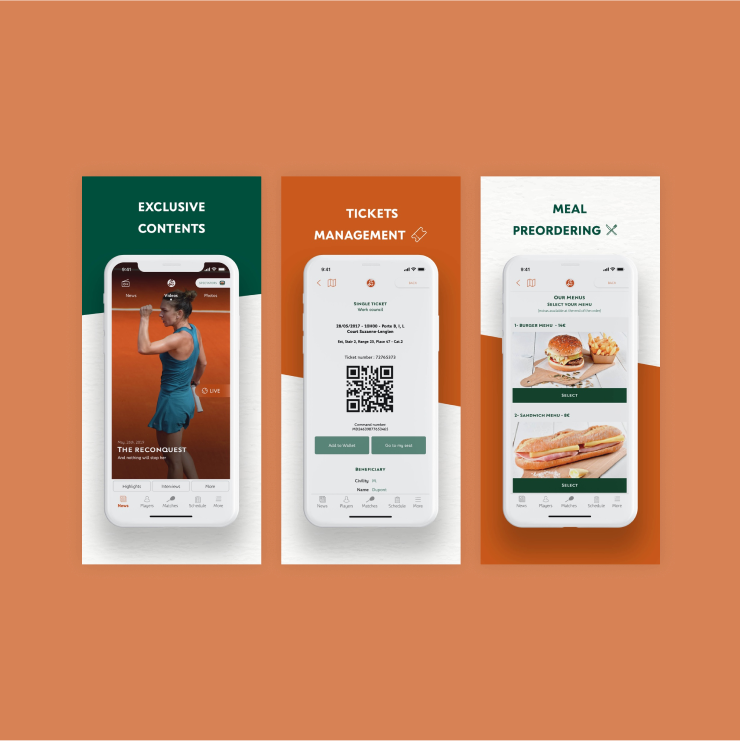Roland Garros Digital Products
![]()

MISSION
During the early phases of my product management and design journey, I undertook a transformative mission: to conceptualise and manage a comprehensive suite of digital products for the renowned French tennis grand slam event, Roland Garros. This encompassed a ticketing website, a dedicated tournament media platform, and customised mobile apps for spectators.
At its essence, our mission aimed to create a seamless and captivating tennis fan experience, spanning pre-event anticipation to post-tournament reflection. We focused on spectators, transforming their dreams of a flawless grand slam journey into a vibrant reality.
At its essence, our mission aimed to create a seamless and captivating tennis fan experience, spanning pre-event anticipation to post-tournament reflection. We focused on spectators, transforming their dreams of a flawless grand slam journey into a vibrant reality.
PROCESS
Due to the unique nature of the Roland Garros tournament, occurring only once a year over a span of three weeks, our product iteration cycle couldn't be shortened. This meant that any identified improvements would have to wait for implementation until the following year, demanding a dedicated and thorough approach.
Despite the limited iteration scope, our commitment to excellence remained unwavering. We conducted in-depth research through focus groups, user interviews, and surveys to meticulously map the user journey. Teaming up with specialised agencies, we orchestrated a thoughtfully planned sequence of workshops encompassing strategy, ideation, design review, regular progress updates, and sync sessions to enhance our approach.Prototyping and testing were integral at various stages, ensuring robust products ready for the tournament's demands.
Managing stakeholders was a delicate yet crucial aspect. Balancing the business interests of media, partnerships, and ticketing departments with the preferences of spectators and brand image required careful consideration. Prioritisation, though challenging, was approached with a collaborative spirit.
While our in-house product team was compact, it offered ample opportunities for broad learning. I delved into user research, journey mapping, wireframing, and prototyping. Visual design was elevated by a comprehensive and modular graphic chart. I played a direct role in crafting a diverse range of visual assets, aligning each creation with the chart's guiding principles.
Throughout the tournament, we gathered firsthand feedback by engaging various user groups through interviews. Post-tournament, we leveraged surveys and group panels to distill insights. Rigorous data collection across the product line complemented this qualitative approach, providing a well-rounded basis for analysis. Both qualitative and quantitative insights shaped the course for the following year, forming a comprehensive and lengthy annual iteration cycle tailored to the distinctive nature of the event.
Despite the limited iteration scope, our commitment to excellence remained unwavering. We conducted in-depth research through focus groups, user interviews, and surveys to meticulously map the user journey. Teaming up with specialised agencies, we orchestrated a thoughtfully planned sequence of workshops encompassing strategy, ideation, design review, regular progress updates, and sync sessions to enhance our approach.Prototyping and testing were integral at various stages, ensuring robust products ready for the tournament's demands.
Managing stakeholders was a delicate yet crucial aspect. Balancing the business interests of media, partnerships, and ticketing departments with the preferences of spectators and brand image required careful consideration. Prioritisation, though challenging, was approached with a collaborative spirit.
While our in-house product team was compact, it offered ample opportunities for broad learning. I delved into user research, journey mapping, wireframing, and prototyping. Visual design was elevated by a comprehensive and modular graphic chart. I played a direct role in crafting a diverse range of visual assets, aligning each creation with the chart's guiding principles.
Throughout the tournament, we gathered firsthand feedback by engaging various user groups through interviews. Post-tournament, we leveraged surveys and group panels to distill insights. Rigorous data collection across the product line complemented this qualitative approach, providing a well-rounded basis for analysis. Both qualitative and quantitative insights shaped the course for the following year, forming a comprehensive and lengthy annual iteration cycle tailored to the distinctive nature of the event.
OUTCOME
Roland Garros’ mobile apps and media content website served 15+ million unique visitors per year and user engagement improved by 15%.
The Roland Garros apps keep improving and are rated 4.6 on the App Store and 4.7 on the Play Store.
The Roand garros ticketing website won a design award, served 2+ million users with 400,000+ annual ticket sales, with 10%+ annual revenue increase.
The Roland Garros apps keep improving and are rated 4.6 on the App Store and 4.7 on the Play Store.
The Roand garros ticketing website won a design award, served 2+ million users with 400,000+ annual ticket sales, with 10%+ annual revenue increase.